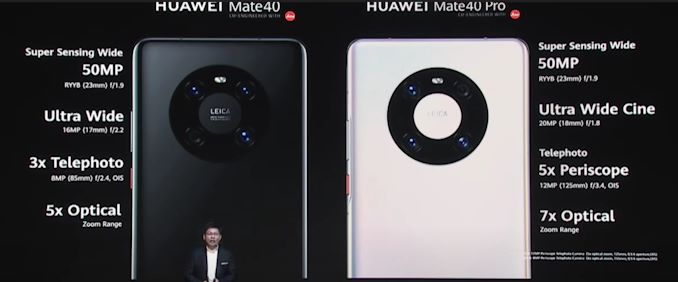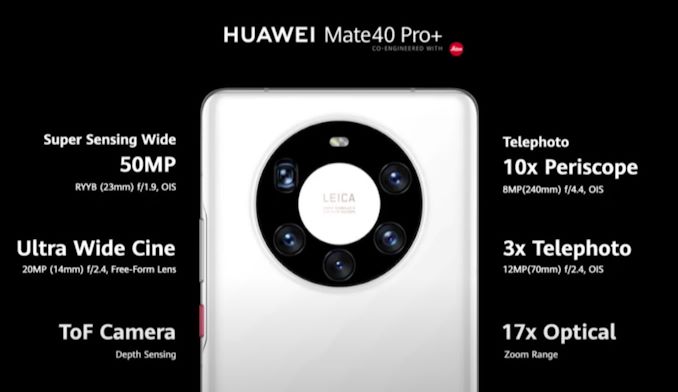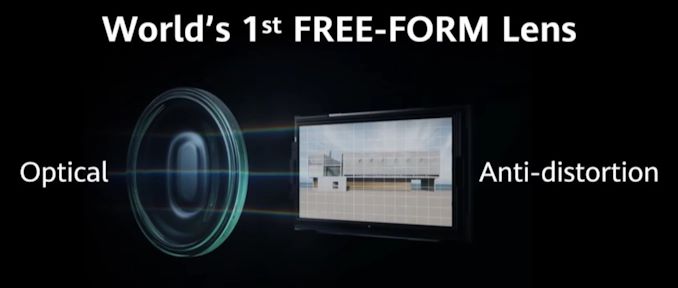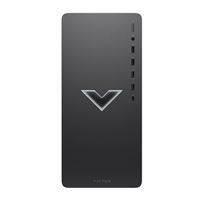Tổng số phụ: 1,650 $
Powered by 15.3bn Transistors 5nm Kirin 9000
At this time Huawei took the stage to unveil the brand new Mate 40 collection of units. Within the type of the Mate 40, Mate 40 Professional and the Mate 40 Professional+, the brand new telephones symbolize the corporate’s vanguard by way of expertise, principally enabled by the brand new Kirin 9000 chipset which is manufactured on a brand new 5nm manufacturing node, promising nice leaps in efficiency and effectivity.
The brand new telephones additionally characteristic an up to date design with a distinct digicam format, differentiated show design and improved audio system and charging options.
The brand new Kirin 9000 is on the core of the dialogue – and it’s additionally Huawei’s greatest drawback as the brand new silicon is now not below manufacturing since September resulting from US sanctions on the corporate, representing a way more substantial menace than the already present limitations on the corporate’s merchandise, corresponding to not with the ability to ship with Google Cell Providers.
| Huawei Mate 40 Sequence | ||||
| Mate 40 | Mate 40 Professional | Mate 40 Professional+ | ||
| SoC | HiSilicon Kirin 9000(E)
1x Cortex-A77 @ 3.13 GHz |
|||
| GPU | Mali G78MP24 Mali G78MP22(E) |
|||
| DRAM | 8GB | 12GB | ||
| Show | 6.5″ OLED 2376 x 1080 90Hz 240Hz Contact 68° edge curve |
6.76″ OLED 2772 x 1344 90Hz 240Hz Contact 88° edge curve |
||
| Measurement | Top | 158.6mm | 162mm | |
| Width | 72.5mm | 75.5mm | ||
| Depth | 8.8mm | 9.1mm | 8.8mm | |
| Weight | 188g | 212g | 230g | |
| Battery Capability | 4100mAh (Rated) 4200mAh (Typical) 40W SuperCharge |
4300mAh (Rated) 4400mAh (Typical) 50W SuperCharging |
||
| Wi-fi Charging | – | 66W SuperCharge | ||
| Rear Cameras | ||||
| Predominant | 50MP 1/1.28″ 2.44µm RYYB sensor
f/1.9 |
+ OIS | ||
| Telephoto | 3x Optical 8MP f/2.4 OIS 85mm eq. |
– | 3x Optical 8MP f/2.4 OIS 70mm eq. |
|
| Periscope Telephoto |
– | 5x Optical 12MP RYYB f/3.4 OIS 125mm eq. |
10x Optical 8MP f/4.4 OIS 240mm eq. |
|
| Large | 16MP f/2.2 17mm eq. |
20MP f/1.8 18mm eq.
|
20MP f/2.4 14mm eq. zero distortion |
|
| Additional | Laser AF | Laser AF + ToF |
||
| Entrance Digicam | Sure | 13MP Large-angle f/2.4 + TOF sensor |
||
| Storage | 128GB | 256GB | 256GB | |
| + proprietary “nanoSD” card | ||||
| I/O | USB-C 3.5mm jack |
USB-C | ||
| Wi-fi (native) | 802.11ax (Wifi 6), Bluetooth 5.2 |
|||
| Mobile | 4G + 5G NR NSA+SA Sub-6GHz | |||
| Splash, Water, Mud Resistance | IP68 (water-proof as much as 1m) |
|||
| Twin-SIM | 2x nano-SIM | |||
| Launch OS | AOSP 10 w/ EMUI 11
with out Google providers |
|||
| Launch Worth | 8+128GB: 899€ |
8+256GB: 1199€ |
12+256GB: 1399€ |
|
As talked about, the most important information at the moment was the official unveiling of the brand new HiSilicon Kirin 9000 SoC. Manufactured on TSMC’s model new 5nm course of node, the Kirin 9000 represents the second and certain solely different chip design after Apple’s A14 to ship in 2020. Huawei had made quite a lot of parallels to Apple’s and Android SoC opponents corresponding to Qualcomm – specializing in some essential milestones that the competitors hasn’t but been capable of obtain on the high-end section, corresponding to integrating the 5G modem inside the SoC as an alternative of counting on an exterior chip. On this regard, Huawei calls the Kirin 9000 the primary and solely 5nm 5G SoC.
The chip can also be of considerable complexity, as Huawei discloses if options 15.3 billion transistors, 30% greater than the lately introduced Apple A14 which “solely” options 11.8bn. A proof for the vastly bigger die measurement in fact is the inclusion of an on-die modem which is at the moment missing in different SoCs from the competitors (resulting from numerous design & price causes). Nonetheless, the modem isn’t the one IP block that bloats up the die measurement, as HiSilicon opted for a fairly gigantic GPU configuration:

That includes a Mali-G78MP24, we’re truly seeing the chip designers depend on the utmost configuration of the G78 IP that Arm affords. HiSilicon had beforehand skipped the Mali-G77 era which truly had been a big architectural change for Mali GPUs so it’s not precisely comparable, however the earlier era Kirin 990 used an 16-core Mali-G76, which is dwarfed by the brand new 24-core GPU. A extra legitimate comparability would by the Exynos 990 with its G77MP11 configuration – and right here the brand new Kirin 9000 options primarily 2.2x the cores.
Undoubtedly TSMC’s new 5nm node density permits for designers to make use of extra transistors in the identical space, however this new GPU continues to be fairly a freak that comes fairly unexpectedly, given the corporate’s historical past on specializing in price, slightly than all-out efficiency. By way of absolute efficiency metrics, the Kirin 9000 is quoted at being 52% quicker than the Snapdragon 865+, which is a really massive leap and will put the SoC and the Mate 40 collection close to the highest positions by way of efficiency.
We don’t but know the clock frequencies of the design, however I count on it to be very low given the big variety of cores, representing an excessive case of a “vast and sluggish” configuration.

The remainder of the SoC additionally has seen updates, though not fairly as massive inside the aggressive panorama. The CPUs have been up to date from Cortex-A76 cores to the newer Cortex-A77 IP, and HiSilicon has shifted from a 2+2+4 design to a 1+3+4 design, very similar to seen in current era Qualcomm chips. The brand new cores clock as much as 3.13GHz on the quickest core, which is a slight lead over the Snapdragon 865+. HiSilicon’s product cycle implies that it hardly ever manages to catch Arm’s new CPU IP launch cycle, and as we anticipated doesn’t make the most of the newer A78 or X1 CPUs that we count on from upcoming Exynos and Snapdragon chipsets in a couple of months.
Different enhancements of the SoC embrace a brand new era NPU – truly this right here depends upon the binning variant of the SoC as HiSilicon may have each a daily Kirin 9000 in addition to a lower-end Kirin 9000E which can differ by way of a barely smaller GPU with 22 cores and just one huge NPU core slightly than two within the quickest SoC bin. It’s seemingly that the GPU takes up such a lot of space on the chip that HiSilicon needed to resort to purposeful binning of the chip to get out extra working models, one thing we hardly ever see within the cell house as power-binning is the popular methodology of binning.
The brand new chip contains a new hybrid LPDDR4X/5 reminiscence controller, and the Mate 40 collection ought to characteristic the latter LP5 reminiscence, though Huawei hasn’t but confirmed the precise specs.
There’s additionally a brand new era picture sign processor which is claimed to enhance HDR for each stills and video recording. Huawei additionally now boasts that that is the threerd era 5G modem, promising important benefits over the competitors such because the Qualcomm X55 modem.

The 5nm manufacturing node additionally brings with it energy effectivity enhancements, and an important disclosure right here is the truth that Huawei is promising 25% higher CPU effectivity versus the Snapdragon 865+. Provided that each SoCs have nearly the identical CPU configuration at very related clock frequencies, nearly all of that 25% determine needs to be as a result of course of node enhancements, which bodes effectively for future 5nm chipsets, in addition to Apple’s A14 chip.
The large elephant within the room is the truth that the Kirin 9000 goes to be a unicorn product – resulting from US sanctions TSMC now not is allowed to provide silicon for Huawei and has stopped delivering chipsets final September 15th. Speculations are that Huawei had solely managed to obtained 3-5 million models – the precise quantity is unknown as Huawei refuses to touch upon the matter.

By way of the precise units, we’ve seen the bulletins of three telephones. The “common” Mate 40 contains a less complicated design and reminds us extra of a OnePlus 8 when considered from the entrance, distinguished by a 6.58” OLED display with a 2376 x 1080 decision. Huawei opts for a mid-range 90Hz refresh price however does supply a 240Hz contact sampling price. Total, this variant of telephone appears fairly easy.

The Mate 40 Professional and Professional+ however have a extra unique design as Huawei once more resorted to a curved display design that falls to the edges with an 88° curvature. Huawei had used such a design earlier than within the Mate 30 Professional, and admittedly I discovered it to be annoying and a foul design that was simply impractical. The brand new Mate 40 Professional’s don’t appear to showcase any important enhancements and thus I nonetheless must get a hands-on with the units, I’m fairly sceptical in regards to the ensuing ergonomics of the telephones.
The display is 6.76” – slightly bigger resulting from it flowing to the aspect of the telephone, and the decision is 2772 x 1344, that includes the identical 90Hz refresh price and 240Hz sampling price.
Generally, this newer era represents a much bigger form-factor design than the Mate 30 Professional collection as Huawei has elevated the width of the telephone from 73.1mm to 75.5mm, primarily a step-size bump by way of system measurement, corresponding to going from an S20+ to an S20 Extremely.
Weight has consequently additionally gone up from 198g to 212g. Battery measurement is described at 4400mAh typical capability which is definitely 100mAh decrease than the Mate 30 Professional. Huawei nonetheless says that as a result of effectivity of the SoC and the general system, it ought to final for longer than competing smartphones.

By way of digicam setup, the brand new system’s {hardware} isn’t all too new in comparison with the P40 collection.
All of the fashions characteristic the identical important digicam module: a 50MP RYYB sensor with a 1/1.28” measurement and 1.22µm pixels, binning all the way down to 2.44µm for 12.5MP photographs. The optics are a large 23mm equal lens with f/1.9 aperture. The primary drawback of this module was that Huawei’s default digicam settings all the time crops in to a 27mm equal field-of-view, producing outstretched native 10MP photographs that all the time upscaled as much as 12.5MP which wasn’t all the time nice. The advantages of the sensor are available low-light the place Huawei’s telephones are nonetheless unbeatable.
It is to be famous that the primary digicam solely options OIS on the Professional+ variant of the telephone, which is a slightly very dangerous differtiation to make by way of product segmentation because it’ll give a worse off expertise for almost all of customers.
The ultra-wide on the Mate 40 is a 16MP unit with f/2.2, whereas on the Mate 40 Professional it’s an 20MP unit with f/1.8.
The telephoto models are additionally the identical as on the P40 collection; the Mate 40 solely comes with a 3x optical 12MP unit with f/2.4 aperture and OIS, while the P40 Professional makes use of the 5x optical 12MP f/3.4 unit with OIS. These end in respectively 85mm and 125mm equal focal lengths.

The Mate 40 Professional+ switches the periscope unit to a 10x optical magnification with a 240mm equal focal size with a smaller 8MP sensor and f/4.4 aperture, with OIS, and features a fourth module within the type of a 12MP 3x optical 70mm equal 12MP f/2.4 unit with OIS.

The one actual in fascinating new announcement on the a part of the digicam setup was on the Mate 40 Professional+’s ultra-wide unit. If options the identical 20MP sensor as on the Mate 40 Professional, nonetheless the optics now embrace a free-form lens which permits the digicam to seize distortion-free and rectilinear photographs – one thing which all different smartphones at the moment have to attain through software program corrections with massive high quality compromises in the direction of the perimeters of the body. Having a free-form lens ought to end in glorious picture high quality that’s above the competitors – it’s only a pity that Huawei is simply utilizing this on the costlier Mate 40 Professional+.
By way of digicam picture high quality enhancements, Huawei claims a lot better HDR processing that’s above the competitors this era, in addition to simply total a significantly enhance digicam software program expertise.
Different enhancements of the telephones embrace higher audio system, reaching a claimed 150% higher bass response, in addition to the introduction of 66W wi-fi charging and 50W wired charging.
Unclear Availability, Nonetheless Excessive Pricing
The Mate 40 is available in at 899€ in 8+128GB configuration, the Mate 40 Professional is available in at 1199€ for a 8+256GB config, and eventually the Mate 40 Professional+ lands in at a whopping 1399€ for a 12+256GB mannequin.
Generally, the Mate 40 collection appears fascinating on paper, nonetheless will nonetheless proceed to be stricken by the truth that Huawei can’t ship the telephones with Google Cell Providers. It’s been a yr since Huawei first launched the Mate 30 collection with out the Google Play retailer, and has been making headways in their very own in-house app retailer, the AppGallery, however even at the moment it’s lacking a ton of purposes that quite a lot of customers would think about essential to a cell smartphone expertise.
Subjective design opinions apart, the Mate 40 appear to supply glorious {hardware} regardless that the premium fashions symbolize fairly a big value bump.
The largest query for Huawei might be how and the place they are going to be promoting these telephones. The launch occasion at the moment consists of costs in Euros, however it’s unclear precisely during which markets the corporate will truly be promoting the telephones, and which of the variants might be accessible. There’s additionally the urgent matter that Huawei solely has a hard and fast and restricted provides of Kirin chips accessible – placing a cap on the quantity of Mate 40 models the corporate can promote. Given all these uncertainties, Huawei has some very exhausting occasions forward of it.




 Apple iPad 10.9-inch tenth Era MPQ93LL/A (Launched Late 2022) - Blue
Apple iPad 10.9-inch tenth Era MPQ93LL/A (Launched Late 2022) - Blue  HP Victus 15L TG02-2051 Gaming Desktop Pc
HP Victus 15L TG02-2051 Gaming Desktop Pc 

